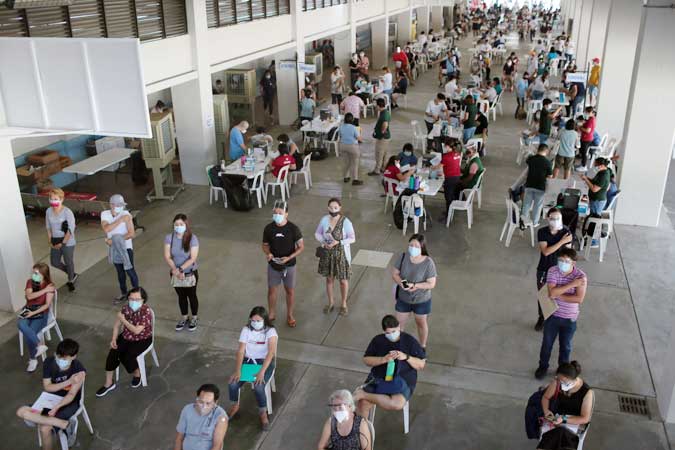THE GOVERNMENT will continue to prioritize the mass vaccination program in next year’s national budget. — PHILIPPINE STAR/ MICHAEL VARCAS
THE DEPARTMENT of Budget and Management (DBM) identified six priority areas for next year’s P5.024-trillion national budget, such as the continuing coronavirus vaccine rollout and increased support for local governments, citing the need for belt-tightening measures amid “very limited fiscal space.”
At the same time, the DBM ordered government agencies to identify savings from their unspent 2020 budgets to augment pandemic relief measures.
Budget Secretary Wendel E. Avisado on Monday issued National Budget Memorandum No. 140, which laid out key programs that will receive priority funding in the 2022 budget, namely coronavirus disease 2019 (COVID-19) vaccines and booster shots, assistance for “disadvantaged” local government units (LGUs), establishment of a virology center, national identification system, and programs for family planning and nutrition.
“[The memorandum provides] information on the very limited FY 2022 fiscal space available for Tier 2 given the adverse effect of the coronavirus disease on economic activity and the revenue collections of the government since last year,” the DBM said.
“As a result, the selection of programs/projects to be prioritized for funding under the said fiscal space under Tier 2 has to be strategic and will yield the maximum results desired,” it added.
Agencies have to submit their proposals for new or increased spending under the Tier 2 budget, while those under Tier 1 refer to ongoing spending requirements.
The DBM said even those under Tier 1 can still be changed and adjusted given the limited fiscal space.
In a separate Viber message, Mr. Avisado had said that the agency will submit the proposed P5.024-trillion 2022 general appropriations measure to Congress “within the period prescribed in the Constitution.”
The Constitution mandates the Executive branch to submit budget proposals to Congress 30 days before the State of the Nation Address (SONA). President Rodrigo R. Duterte is scheduled to give his final SONA on July 26.
In the circular, the DBM said the government’s continuing vaccination program, particularly the COVID-19 booster shots, will be prioritized for Tier 2 funding.
“According to the Vaccine Expert Panel, there is a need for booster shots to strengthen the immunity of those who already received the COVID-19 vaccine to prevent the adverse symptoms of the disease. This will provide added protection against the other variants of the virus to keep the public safe,” the Budget department said.
The government will have to allocate P75 billion for the booster shots, in addition to the P72.5-billion budget to vaccinate at least 60 million Filipino adults this year, according to Finance Secretary Carlos G. Dominguez III.
Another key program to be prioritized under the 2022 budget is the National Government’s assistance to LGUs, since several projects will be devolved to them in response to the Supreme Court’s ruling on the Mandanas-Garcia Case, which increased their share from the National Government’s revenues or the Internal Revenue Allotment (IRA).
The government is proposing a Growth Equity Fund (GEF) which will be used to support LGUs with the highest poverty rate and which are struggling financially.
Once the fund is in place, the DBM said proposals for new and expanded local projects by National Government agencies that will be devolved next year will no longer be funded under the Tier 2 budget.
“The GEF aims to cover the funding and capacity development requirements of basic infrastructure and other programs, projects and activities of poor, disadvantaged and lagging LGUs to gradually enable them to implement the functions and services devolved to LGUs by pertinent laws more effectively and efficiently,” it said.
The DBM will also prioritize capacity development programs for LGUs.
The government is also giving top priority for the establishment of the Virology Science and Technology Institute of the Philippines, which aims to become the country’s “premier research institute on virology of humans, animals and plants.”
Programs for family planning and nutrition are also included in the priority list to address high population in cities and the persistent malnutrition problems faced by children.
The DBM said faster rollout of the Philippine Identification System (PhilSys) or the national ID system will also be prioritized next year.
“Interoperability across government agencies shall also be pursued by revisiting existing systems and databases to ensure that the PhilSys numbers will be utilized in generating and processing data information,” it added.
Other new and expanded programs to be considered for funding will be limited to those in the updated Philippine Development Plan (PDP), and the three-year Rolling Infrastructure Program of the National Economic and Development Authority (NEDA).
SAVINGS
Meanwhile, Mr. Avisado issued National Budget Circular No. 586 dated May 21 directing all government departments and agencies to identify savings from their unspent 2020 budgets as of May 15. These unobligated funds exclude those for the implementation of pandemic response programs.
“Within the Executive Branch, the President is authorized to declare and use savings to augment any deficient item related to measures intended to alleviate the effects of the COVID-19 pandemic, including provision for emergency subsidies to low-income households and disadvantaged or displaced workers affected by the pandemic,” he said.
The DBM requires agencies to submit their records by May 31. Mr. Duterte will then identify the savings that can be pooled and used to add to the government’s war chest against COVID-19.
Currently, the economic team estimated that P170 billion can be spent to fund a third stimulus package without ballooning this year’s budget deficit past the ceiling equivalent to 9.4% of gross domestic product (GDP).
The economic team expects GDP to grow by 7-9% next year, much slower than the previous estimate of an 8-10% expansion. — Beatrice M. Laforga

